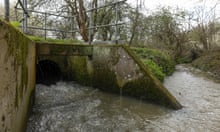Thames Water dumped untreated effluent for more than 68,000 hours into the river systems around Oxford last year, campaigners have revealed, arguing that the sum of money the company plans to spend to improve the situation is woefully inadequate.
The company discharged raw sewage into the River Thames and its tributaries including the River Windrush, Thame, Evenlode and Ock 5,028 times in 2021, according to data analysed by the Oxford Rivers Improvement Campaign (ORIC).
Using data from Thames Water and applying the Environment Agency formula for capacity required at any treatment works, the campaigners assessed that the 10 large sewage treatment works operating in the upper Thames area – from Didcot in the south to Moreton-in-Marsh and Bourton-on-the-Water in the Cotswolds – were unable to treat the full capacity of sewage for the population of 1.1 million.
Their calculations indicate Oxford and Witney treatment works can cope with only 62% of the capacity needed for the population, and the treatment works in Banbury is sufficient for just 49% of the required capacity.
The failure to invest in the capacity of the treatment works had led to more raw sewage in the rivers, the campaigners said. All 10 works discharged sewage into the rivers in 2021 for an average of 11 hours a week. Oxford sewage treatment works released raw sewage into the waters for 892 hours in 2021, Swindon for 501 hours and Witney for 935 hours.
Thames Water is investing in the improvement of four of the large treatment works and 11 smaller works – just a third of the works that need to be expanded to stop sewage discharges into the rivers, according to the ORIC. When population increases are taken into consideration, the investment plans cover just a quarter – 15 of 57 – treatment works needing investment by 2025.
“The simple truth is that Thames Water’s plans are completely inadequate,” said Mark Hull, a former water industry consultant and founding member of ORIC. “Given the well-established and longstanding problems faced across the upper Thames region, it is scandalous that appropriate and coordinated investment plans for the whole region are not in place.
“Thames Water and the government’s Environment Agency have failed to deal with this problem over many years. Their ongoing underperformance beggars belief – especially as the industry’s financial regulator, Ofwat, have made it clear that they would not oppose the necessary investment.”
The report, published on Wednesday by ORIC, found that even where Thames Water had planned investment, the expansion of capacity could be insufficient for the 2020s and 2030s. At Witney treatment works the investment will increase capacity by 50% increase but that would improve the works to only 93% of the required capacity based on the 2020 population, the report says.
Across the upper Thames, 102 sewage treatment works discharged into the rivers in 2021. Forty-nine of them discharged for more than 10 hours a week; and almost quarter of the works discharged for more than 1,000 hours in the year.
The campaign group analysed the scale of raw sewage discharges in the upper Thames from the Environment Agency’s data for 2021. It also examined the agency’s database of investments by water companies.
Hull said: “Government, the Environment Agency and Thames Water keep telling us that they are dealing with the problems. The truth is simple. They are not.”
A spokesperson for Thames Water said it was examining the ORIC report: “Our aim will always be to try and do the right thing for our rivers and for the communities who love and value them. We regard all discharges of untreated sewage as unacceptable and will work with the government, Ofwat and the Environment Agency to accelerate work to stop them being necessary and are determined to be transparent.
“We recently launched our river health commitments, which include a 50% reduction in the total annual duration of spills across London and the Thames Valley by 2030, and within that an 80% reduction in sensitive catchments. We have a long way to go – and we certainly can’t do it on our own – but the ambition is clear.”










